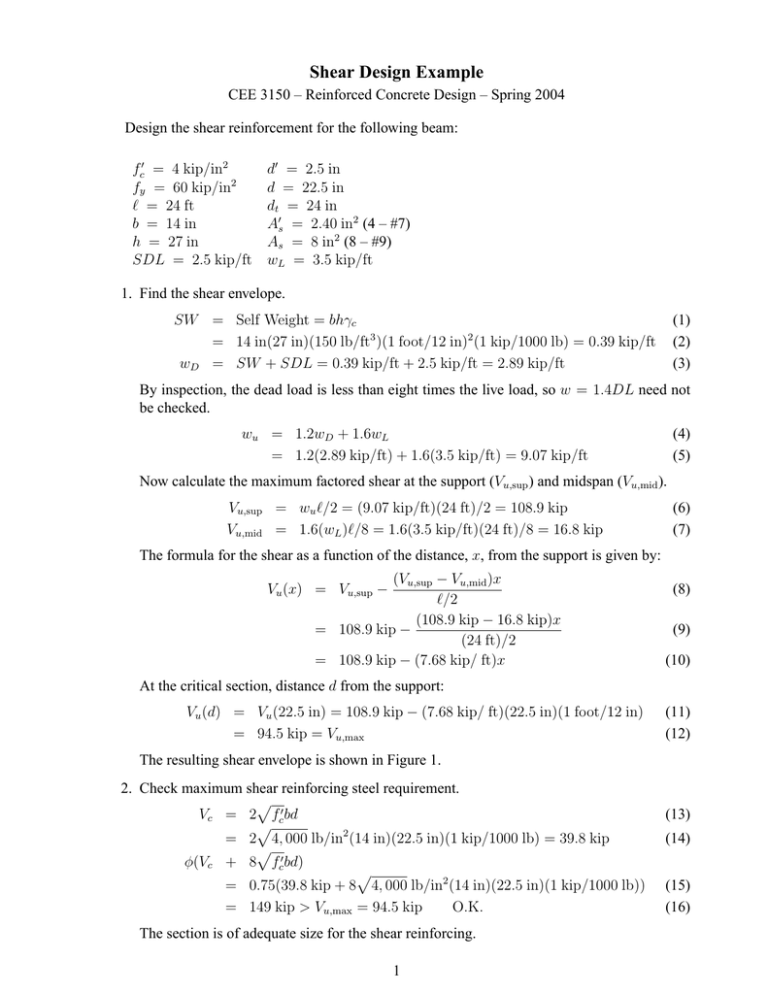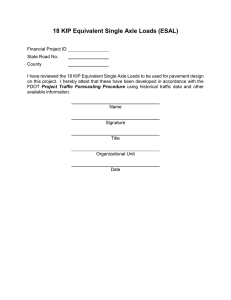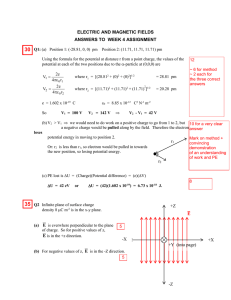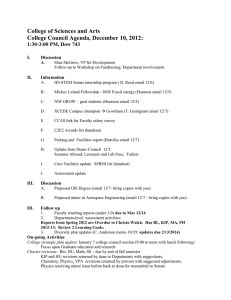Shear Design Example
advertisement

Shear Design Example
CEE 3150 – Reinforced Concrete Design – Spring 2004
Design the shear reinforcement for the following beam:
fc0 = 4 kip/in2
fy = 60 kip/in2
` = 24 ft
b = 14 in
h = 27 in
SDL = 2.5 kip/ft
d0 = 2.5 in
d = 22.5 in
dt = 24 in
A0s = 2.40 in2 (4 – #7)
As = 8 in2 (8 – #9)
wL = 3.5 kip/ft
1. Find the shear envelope.
SW = Self Weight = bhγc
= 14 in(27 in)(150 lb/ft3 )(1 foot/12 in)2 (1 kip/1000 lb) = 0.39 kip/ft
wD = SW + SDL = 0.39 kip/ft + 2.5 kip/ft = 2.89 kip/ft
(1)
(2)
(3)
By inspection, the dead load is less than eight times the live load, so w = 1.4DL need not
be checked.
wu = 1.2wD + 1.6wL
= 1.2(2.89 kip/ft) + 1.6(3.5 kip/ft) = 9.07 kip/ft
(4)
(5)
Now calculate the maximum factored shear at the support (Vu,sup ) and midspan (Vu,mid ).
Vu,sup = wu `/2 = (9.07 kip/ft)(24 ft)/2 = 108.9 kip
Vu,mid = 1.6(wL )`/8 = 1.6(3.5 kip/ft)(24 ft)/8 = 16.8 kip
(6)
(7)
The formula for the shear as a function of the distance, x, from the support is given by:
(Vu,sup − Vu,mid )x
`/2
(108.9 kip − 16.8 kip)x
= 108.9 kip −
(24 ft)/2
= 108.9 kip − (7.68 kip/ ft)x
Vu (x) = Vu,sup −
(8)
(9)
(10)
At the critical section, distance d from the support:
Vu (d) = Vu (22.5 in) = 108.9 kip − (7.68 kip/ ft)(22.5 in)(1 foot/12 in)
= 94.5 kip = Vu,max
(11)
(12)
The resulting shear envelope is shown in Figure 1.
2. Check maximum shear reinforcing steel requirement.
p
Vc = 2 fc0 bd
p
= 2 4, 000 lb/in2 (14 in)(22.5 in)(1 kip/1000 lb) = 39.8 kip
p
φ(Vc + 8 fc0 bd)
p
= 0.75(39.8 kip + 8 4, 000 lb/in2 (14 in)(22.5 in)(1 kip/1000 lb))
= 149 kip > Vu,max = 94.5 kip
O.K.
The section is of adequate size for the shear reinforcing.
1
(13)
(14)
(15)
(16)
100
90
80
Vu (kip)
70
60
50
40
30
20
10
0
0
2
4
6
x (ft)
8
10
12
Figure 1: The shear envelope.
3. Pick stirrup size and set spacing. To begin, we determine the distance from the support to
the end of Zone C.
φVc = 0.75(39.8 kip) = 29.9 kip
Vu (x) = 108.9 kip − (7.68 kip/ ft)x = φVc = 29.9 kip
(108.9 kip − 29.9 kip)
⇒x =
= 10.3 ft
(7.68 kip/ft)
(17)
(18)
(19)
Zone C ends 10.3 feet from the support, which is shown graphically by the dotted line in
Figure 1. Try a #3 stirrup (Ab = 0.11 in2 ⇒ Av = 0.22 in2 ). Use Vu,max to calculate the
stirrup spacing, s.
s =
Av fy d
Vu,max
− Vc
φ
2
0.22 in (60 kip/in2 )(22.5 in)
94.5 kip
− 39.8 kip
0.75
= 3.45 in
=
(20)
(21)
(22)
Spacing is inadequate: it is best to use s ≥ 4 in. Try a #4 stirrup (Ab = 0.20 in2 ⇒ Av =
0.40 in2 ):
0.40 in2 (60 kip/in2 )(22.5 in)
94.5 kip
− 39.8 kip
0.75
= 6.26 in
s =
(23)
(24)
Use s = 6 in as the stirrup spacing. The shear capacity of the stirrups, Vs is then calculated
as:
Av fy d
0.40 in2 (60 kip/in2 )(22.5 in)
Vs =
=
= 90 kip
(25)
s
6 in
p
This value must be compared to 4 fc0 bd to check maximum spacing:
p
p
4 fc0 bd = 4 4, 000 lb/in2 (14 in)(22.5 in)1 kip/1000 lb = 79.7 kip
(26)
2
p
Thus, because Vs > 4 fc0 bd, the spacing must satisfy
s ≤ min(d/4, 12 in) = min((22.5 in)/4, 12 in) = (22.5 in)/4 = 5.63 in
(27)
Use an initial spacing of 5 inches to meet the maximum spacing of 5.6 inches. We should
change spacing at most two or three times. If we increase spacing to s = 8 in:
0.40 in2 (60 kip/in2 )(22.5 in)
= 67.5 kip
(28)
8 in
p
Because the shear capacity, Vs , at s = 8 in is less than 4 fc0 bd = 79.7 kip, the maximum
spacing is governed by:
Vs =
s ≤ min(d/2, 24 in) = min((22.5 in)/2, 24 in) = (22.5 in)/2 = 11.25 in
(29)
Thus s = 8 in can be used as soon as Vu (x) drops low enough:
φ(Vc + Vs ) = 0.75(39.8 kip + 67.5 kip) = 80.5 kip ≤ Vu (x)
(30)
Solving Vu (x) = 80.5 kip for x gives (see Equation 10):
108.9 kip − (7.68 kip/ ft)x = 80.5 kip
108.9 kip − 80.5 kip
= 3.70 ft
⇒x =
7.68 kip/ ft
(31)
(32)
We will also consider the maximum spacing, s = 11 in:
0.40 in2 (60 kip/in2 )(22.5 in)
= 49.1 kip
11 in
φ(Vc + Vs ) = 0.75(39.8 kip + 49.1 kip) = 66.7 kip
Vs =
(33)
(34)
Solving as before, this spacing may begin 5.5 feet from the support.
Moving on to Zone B, the maximum spacing is s = d/2, or s = 11 in as shown above. We
also need to check the minimum steel area from {ACI 11.5.5.3}:
p
√
0.75 fc0 bw s
0.75 4, 000 lb/in2 (14 in)(11 in)
Av ≥
=
(35)
fy
60, 000 lb/in2
≥ 0.12 in2
(36)
50bw s
50 psi(14 in)(11 in)
Av ≥
=
(37)
fy
60, 000 lb/in2
≥ 0.13 in2
(38)
The larger area (Av ≥ 0.13 in2 ) controls. A #3 would work (Av = 2Ab = 2(0.11 in2 ) =
0.22 in2 ), but we do not want to change bar size. Use a #4 at spacing s = 11 in.
Lastly, determine where Zone A starts:
φVc
0.75(39.8 kip)
=
= 14.9 kip < Vu,mid = 16.8 kip
2
2
(39)
Thus, stirrups are required everywhere since there is no point on the beam where the concrete
alone is twice as strong as it needs to be. That is, there is no Zone A for this problem.
3
Rebar at Center
8 @ 5"
4 @ 8"
6 @ 11"
10"
2"
1
2
3
4
5
6
7
8
9
10
11
x (feet)
Figure 2: Stirrup design layout.
4. Sketch.
The first stirrup will be placed a distance s/2 from the support. The initial spacing is 5 inches
so that the first stirrup would be at 2.5 inches. But, we want to detail everything in whole
inches so use an initial space of 2 inches. Nine additional stirrups at 5 inch spacing takes us to
47 inches past the support or 3.9 ft—a bit past the 3.70 feet calculated above in Equation 32.
Four more stirrups at 8 inch spacing takes us to 71 inches (5.9 feet) and 6 more stirrups at
11 inches on center will leave a 10 inch distance to the reinforcing bar at the midspan.
4
12



